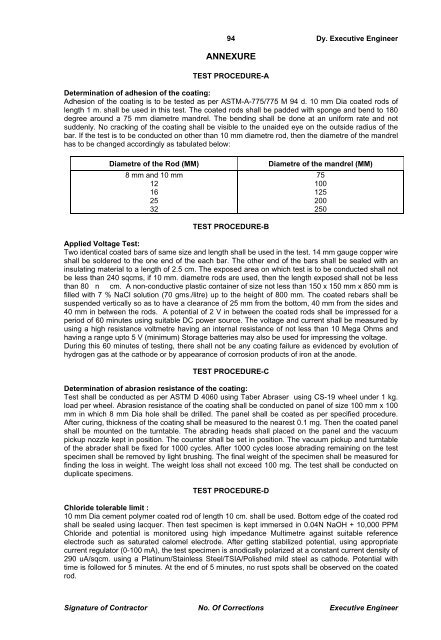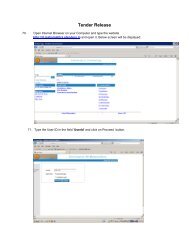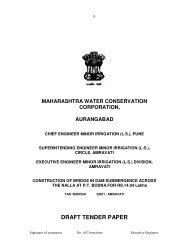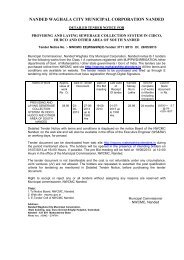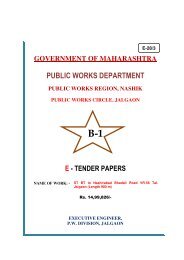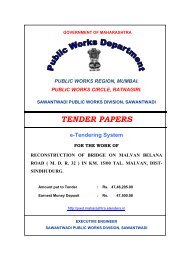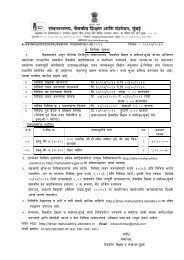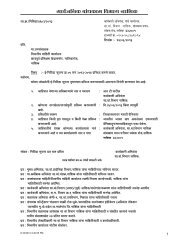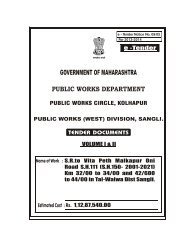B-1 AGREEMENT System Generated e-Tender No ... - e-Tendering
B-1 AGREEMENT System Generated e-Tender No ... - e-Tendering
B-1 AGREEMENT System Generated e-Tender No ... - e-Tendering
You also want an ePaper? Increase the reach of your titles
YUMPU automatically turns print PDFs into web optimized ePapers that Google loves.
94 Dy. Executive Engineer<br />
ANNEXURE<br />
TEST PROCEDURE-A<br />
Determination of adhesion of the coating:<br />
Adhesion of the coating is to be tested as per ASTM-A-775/775 M 94 d. 10 mm Dia coated rods of<br />
length 1 m. shall be used in this test. The coated rods shall be padded with sponge and bend to 180<br />
degree around a 75 mm diametre mandrel. The bending shall be done at an uniform rate and not<br />
suddenly. <strong>No</strong> cracking of the coating shall be visible to the unaided eye on the outside radius of the<br />
bar. If the test is to be conducted on other than 10 mm diametre rod, then the diametre of the mandrel<br />
has to be changed accordingly as tabulated below:<br />
Diametre of the Rod (MM)<br />
8 mm and 10 mm<br />
12<br />
16<br />
25<br />
32<br />
Diametre of the mandrel (MM)<br />
75<br />
100<br />
125<br />
200<br />
250<br />
TEST PROCEDURE-B<br />
Applied Voltage Test:<br />
Two identical coated bars of same size and length shall be used in the test. 14 mm gauge copper wire<br />
shall be soldered to the one end of the each bar. The other end of the bars shall be sealed with an<br />
insulating material to a length of 2.5 cm. The exposed area on which test is to be conducted shall not<br />
be less than 240 sqcms, if 10 mm. diametre rods are used, then the length exposed shall not be less<br />
than 80 n cm. A non-conductive plastic container of size not less than 150 x 150 mm x 850 mm is<br />
filled with 7 % NaCl solution (70 gms./litre) up to the height of 800 mm. The coated rebars shall be<br />
suspended vertically so as to have a clearance of 25 mm from the bottom, 40 mm from the sides and<br />
40 mm in between the rods. A potential of 2 V in between the coated rods shall be impressed for a<br />
period of 60 minutes using suitable DC power source. The voltage and current shall be measured by<br />
using a high resistance voltmetre having an internal resistance of not less than 10 Mega Ohms and<br />
having a range upto 5 V (minimum) Storage batteries may also be used for impressing the voltage.<br />
During this 60 minutes of testing, there shall not be any coating failure as evidenced by evolution of<br />
hydrogen gas at the cathode or by appearance of corrosion products of iron at the anode.<br />
TEST PROCEDURE-C<br />
Determination of abrasion resistance of the coating:<br />
Test shall be conducted as per ASTM D 4060 using Taber Abraser using CS-19 wheel under 1 kg.<br />
load per wheel. Abrasion resistance of the coating shall be conducted on panel of size 100 mm x 100<br />
mm in which 8 mm Dia hole shall be drilled. The panel shall be coated as per specified procedure.<br />
After curing, thickness of the coating shall be measured to the nearest 0.1 mg. Then the coated panel<br />
shall be mounted on the turntable. The abrading heads shall placed on the panel and the vacuum<br />
pickup nozzle kept in position. The counter shall be set in position. The vacuum pickup and turntable<br />
of the abrader shall be fixed for 1000 cycles. After 1000 cycles loose abrading remaining on the test<br />
specimen shall be removed by light brushing. The final weight of the specimen shall be measured for<br />
finding the loss in weight. The weight loss shall not exceed 100 mg. The test shall be conducted on<br />
duplicate specimens.<br />
TEST PROCEDURE-D<br />
Chloride tolerable limit :<br />
10 mm Dia cement polymer coated rod of length 10 cm. shall be used. Bottom edge of the coated rod<br />
shall be sealed using lacquer. Then test specimen is kept immersed in 0.04N NaOH + 10,000 PPM<br />
Chloride and potential is monitored using high impedance Multimetre against suitable reference<br />
electrode such as saturated calomel electrode. After getting stabilized potential, using appropriate<br />
current regulator (0-100 mA), the test specimen is anodically polarized at a constant current density of<br />
290 uA/sqcm. using a Platinum/Stainless Steel/TSIA/Polished mild steel as cathode. Potential with<br />
time is followed for 5 minutes. At the end of 5 minutes, no rust spots shall be observed on the coated<br />
rod.<br />
Signature of Contractor <strong>No</strong>. Of Corrections Executive Engineer


